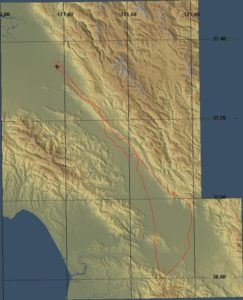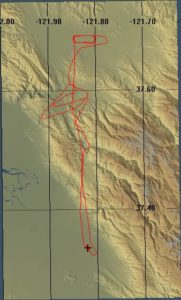 So tonight I am a happy man. All my landings were OK, that is four in a row, not perfect, but definitely OK. So what the hell happened? On Monday I was despondent about ever managing to land an airplane. Well hopefully I’ve found and fixed my block, thankfully it was a simple one. JUST USE BOTH HANDS TO LAND THE PLANE. Yes, up to now, through all the frustrating pattern work at RHV over the last few lessons, I have had my left hand on the yoke and my right hand on the throttle. This was mostly in line with what Yoed said about always keeping a hand on the throttle, and it is a good place to have it on landing. You may need to react quickly with power to go around or recover from a bounced landing. Still, my problem was controlling the flare, it was either too fast, too slow, too early or too late. All this is basically fine motor control of the arm pulling back on the yoke. Well as I’m right handed, I guess I just don’t have that good a control of my left arm. As I was writing last night, I realized that all my best landings had been “simulated” emergency landings, where you pretend that the engine is dead. Hence, there is no point keeping a hand on the throttle, the whole point is getting down safely with it on idle. So I used both hands on the yoke and the landings were OK. I talked with Grainne about this before we started and she said it was no great sin to take your hand off the throttle as long as you were “over the numbers” and assured of your landing, and you were ready to react quickly with power if needed.
So tonight I am a happy man. All my landings were OK, that is four in a row, not perfect, but definitely OK. So what the hell happened? On Monday I was despondent about ever managing to land an airplane. Well hopefully I’ve found and fixed my block, thankfully it was a simple one. JUST USE BOTH HANDS TO LAND THE PLANE. Yes, up to now, through all the frustrating pattern work at RHV over the last few lessons, I have had my left hand on the yoke and my right hand on the throttle. This was mostly in line with what Yoed said about always keeping a hand on the throttle, and it is a good place to have it on landing. You may need to react quickly with power to go around or recover from a bounced landing. Still, my problem was controlling the flare, it was either too fast, too slow, too early or too late. All this is basically fine motor control of the arm pulling back on the yoke. Well as I’m right handed, I guess I just don’t have that good a control of my left arm. As I was writing last night, I realized that all my best landings had been “simulated” emergency landings, where you pretend that the engine is dead. Hence, there is no point keeping a hand on the throttle, the whole point is getting down safely with it on idle. So I used both hands on the yoke and the landings were OK. I talked with Grainne about this before we started and she said it was no great sin to take your hand off the throttle as long as you were “over the numbers” and assured of your landing, and you were ready to react quickly with power if needed.
Today was clear and sunny as usual, ATIS had winds at 300 12 knots and 28C. I took the afternoon off again and I arrived about 20 minutes early. Grainne showed up on time and were went over the plan for today’s flight. South County still has flight restrictions, I assume from the remaining clean up of the Croy Fire so we decided to go to Livermore. Basically, slow flight, power on and power off stalls and some pattern work at LVK. About 2:15pm I went to get the key book and we discovered that N5766J was not back yet. It didn’t turn up until 2:30pm and we were surprised to find it been pushed back into the maintenance hanger. I don’t know if there was anything wrong, but after Grainne had some words with the Mechanic he gave us the plane and we pushed it back out onto the apron. Had a mostly normal preflight, taxi, run-up and take off on 31R, with a right 45 departure.
We climbed up to 4000’ feet and I took a little time to try and pick out my house on the way, couldn’t find it today. It was a little turbulent especially as we passed through 3000’ which happened to be when I wanted to look out of the plane. Anyway, we leveled off over Calaveras Reservoir and I completed the maneuvering checklist, some clearing turns and then some slow flight. Today, we found that stall horn was set at 41 knots. Every time you fly you find the stalling speed is a little different, it’s sensitive to the weather conditions and the exact state of the plane. We spent some time tooling along at 45 knots doing some turns and even a climb which is pretty anemic going so slowly with so much drag. Then we did a series of straight ahead power off stalls. This time I was real quick getting the nose down and the stall recoveries went pretty well. A couple more clearing turns and then we did three power-on stalls. These went fairly well, got the stick forward quickly, though I was maybe a little fast starting the recovery so I heard the stall horn briefly when I started to pull up. Didn’t mind in the least how the nose dropped in the power-on stall and I think I really lost my fear of this maneuver. In general, no problems and I didn’t forget to do anything critical. I need to be a little smoother on the controls, but that just practice.
We were at 3500’ over the Sunol Golf Course, so I got the LVK ATIS, winds variable at 5 knots, temp 28C, so pretty easy weather. Called LVK tower and got cleared to enter their class D airspace for a 45 entry to left traffic for runway 25L. I took a sort of big S turn to loose some altitude before I got into the pattern entry. Called into LVK tower 2 miles on the 45 entry and was told to make a wide downwind because there was another plane just ahead of me in the downwind leg. I followed him and the continued my downwind as he turned base. I waited for him to turn final before making my own turn onto base. So that is why the pattern entry looks so ugly on the GPS track.
LVK has two parallel runways (25L & 25R). The left runway is 2699’ and the right is 5253’. So the threshold of 25L is a long way in from the threshold of 25R. When you are used to the equal length parallel runways in RHV the difference makes judgment of the turn to base harder. Still, the final was good if a little longer than usual and as I came up on the numbers I transferred my right hand to the yoke. The landing was great, as good as anything I had done to date. YES, I thought it was the hands thing. We did the touch and go and had an uneventful circuit through the pattern though ATC changed the radio frequency along the way. A much better turn onto base this time and a fine final approach, again both hands on the yoke over the numbers and again an OK landing with just one small float before we touched down. THANK GOD, I thought the first one wasn’t just a fluke, it really is the hands. Power up for the touch and go and off we went. I checked the time and Grainne said we had time for one more, I was rearing to go to make it three in a row. A third landing just like the first two, beautiful. For the first time I have actually really felt in control of the flare. It wasn’t that hard to do the fine control with both hands, the plane just did what I wanted and landed on the centerline. We did the touch and go again and Grainne asked the Tower for a crosswind departure back to RHV.
As we climbed away I said “I’d like a nice relaxing flight back to RHV”, because I figured Grainne would throw in an emergency landing on the way otherwise. I didn’t want anything to stress me out on what was turning out to be the best flight in a long time. Over Calaveras again I got the RHV ATIS, wind 320 12 knots and temp still 28C. And then got the Tower. They initially must have assumed I was coming from the South because he told me to make straight in for 31L. I said roger, but was thinking that can‘t be right. So I called him back and repeated I was over Calaveras, then he gave me the usual 45 downwind entry for 31R. I should have been a little quicker to correct him the first time, but at least I questioned the direction and got it cleared up. Started a descent from 3000’ and made the entry over Lake Cunningham. I was cleared to land on 31R. As usual no problems on the pattern and the approach was fine, right on glide slope as I came around onto final. Last time was a charm, both hands on the yoke and a fine landing on the centerline, easily exited the runway at taxiway delta.
So are my landing woes behind me, I sure hope so. Grainne seemed happy, she gave me the pre-solo written exam to take home and we decided that we would schedule the stage one checkride for some afternoon next week. It’s a four hour block, 2 hours oral exam and then a 2 hour flight with one of the Senior CFI‘s. I’ll fly with Yoed on Saturday morning and practice my landings some more. Then fly with Grainne on Sunday, practice the emergency landings she said she had put off today due to my “relaxing ride home” comment and maybe a little more pattern work. Flying is fun again.

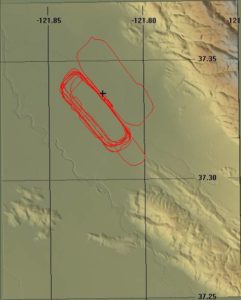
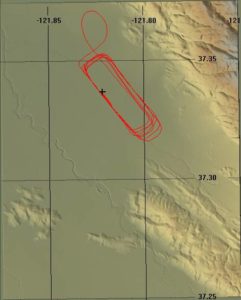
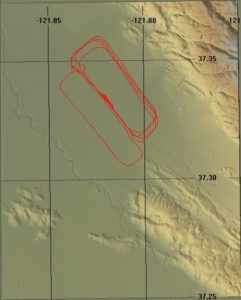
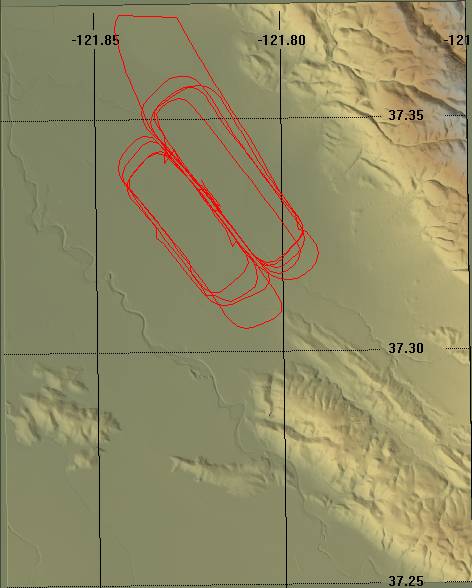
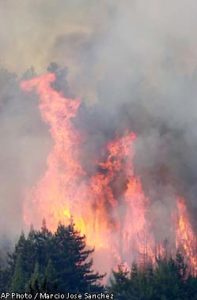
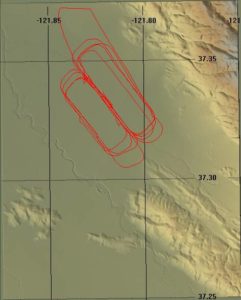
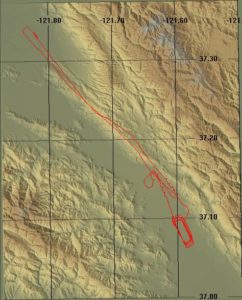
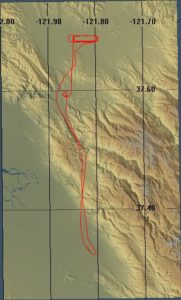
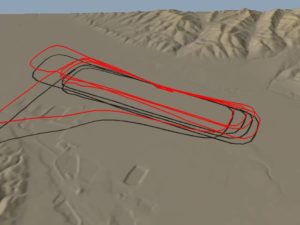
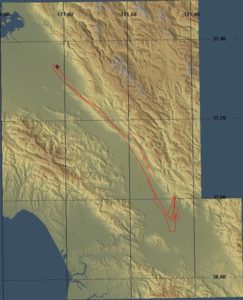
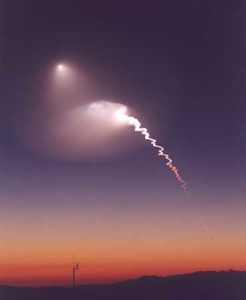 We were just about to push the plane back into its parking space when Yoed said “Is that the rocket launch you told me about”. I had warned him that Vandenberg AFB was scheduled to do a test launch of a Minuteman III missile out into the Pacific and it could happen anytime between 1800 and midnight. In the event they kindly waited for us to get on the ground and for darkness and it was spectacular. The missile climbed out and to the West into a clear dark sky leaving a glowing trail behind it. We saw the second and third stage separations. The photo shown was taken from Southern California, but it looked pretty much the same from the apron at RHV.
We were just about to push the plane back into its parking space when Yoed said “Is that the rocket launch you told me about”. I had warned him that Vandenberg AFB was scheduled to do a test launch of a Minuteman III missile out into the Pacific and it could happen anytime between 1800 and midnight. In the event they kindly waited for us to get on the ground and for darkness and it was spectacular. The missile climbed out and to the West into a clear dark sky leaving a glowing trail behind it. We saw the second and third stage separations. The photo shown was taken from Southern California, but it looked pretty much the same from the apron at RHV.